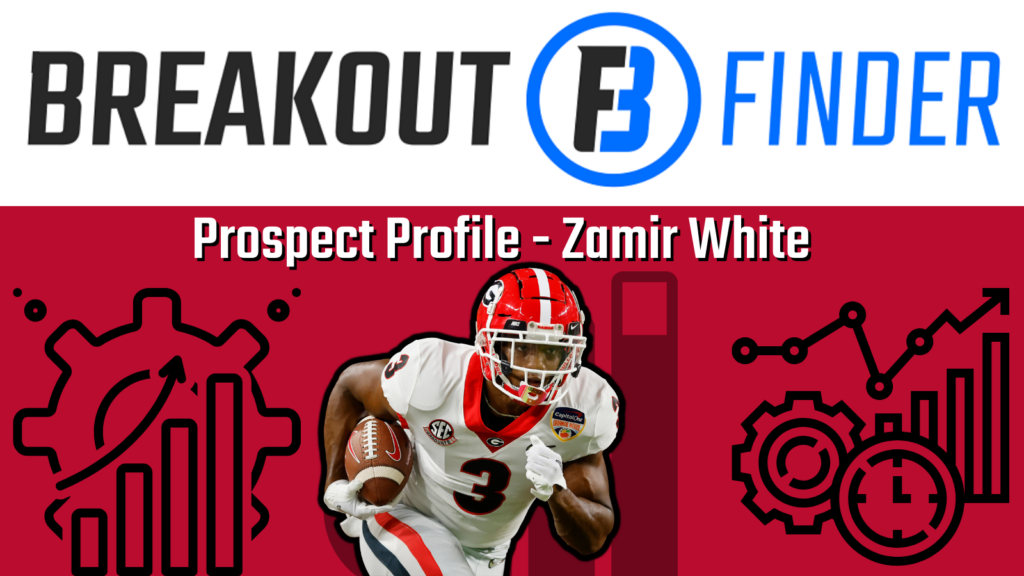
The Georgia boys got busy at their Pro Day. While he didn’t do the three-cone, we have a pretty full athletic profile to work with from Zamir White.
Physical Measurables
With a 4.40-flat in the 40-yard dash at greater than 215-pounds, Zamir White is surely a saint in the eyes of the Speed Score zealots. The rest of his athletic profile is not without questions, though.
His broad jump was excellent while his vertical leap was poor, which is interesting. It’s also likely that he doesn’t have great lateral agility, evidenced by his absolutely abysmal short shuttle time.
Overall, White feels like your classic straight-line speed guy. Based on his measurables, the following historical prospects are the most similar to him from a purely physical standpoint:
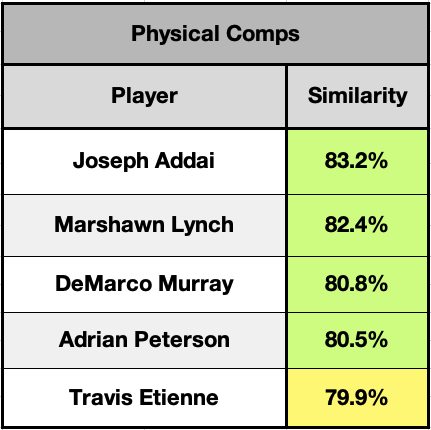
Obviously, this is a pretty tantalizing list of comps. Other than Travis Etienne, every one of these guys have posted high-end RB1 seasons in fantasy. Dudes who are big and can run fast are often good football players.
Production Profile
Good football players are also typically productive football players. Zamir White doesn’t quite stack up in the area:
After taking a medical redshirt in his first year, White played on teams that were consistently really good according to Bill Connolly’s S&P+ rating system. His best season on those teams was his junior campaign. He had 816 yards from scrimmage, 11 TDs and produced a Dominator Rating in the 54th-percentile among third-year runners.
I calculate breakouts by creating a composite between a player’s Dominator Rating and their team’s S&P+ rating. A 54th-percentile Dominator on a 72nd-percentile squad doesn’t quite reach the breakout threshold. And I think that’s intuitive. Does being barely above average on a solid college team really check the “we should expect this guy to be good in the NFL” box? Not in my opinion.
When players don’t break out in college, I consider them to have “broken out” in the year following their final college season. So White gets a year-5 breakout at age 23.0.
Given the seasonal Dominator Ratings he posted and the quality of teams he played for, the following historical prospects had the most similar college production profiles:
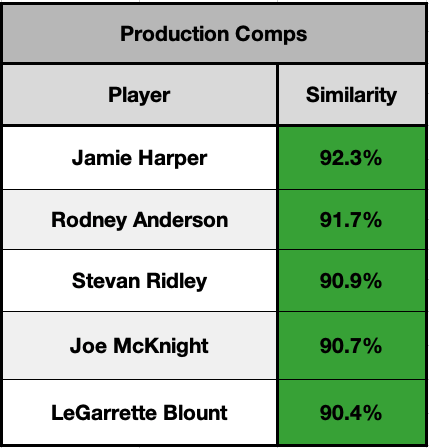
A large reason why White wasn’t incredibly productive is that he went to a powerhouse school with lots of other talented players who deserved touches on offense. So did the above group of players. While it feels like an underwhelming list, Stevan Ridley and LeGarrette Blount have 1,000-yard NFL seasons on their resumés.
Rushing Efficiency
I wrote a full breakdown of Zamir White‘s rushing efficiency numbers that can be found here. But the following is an overview of his profile:
We’ve got quite the rainbow going on here. Essentially what we see is that on fairly low volume, White posted unimpressive efficiency relative to some very talented teammates.
I think part of that is due to injuries suffered early on in his career. White tore his ACL as a high school senior and then again in August of his first year at Georgia. It should come as no surprise that his efficiency numbers have improved every year since that lost freshman season:
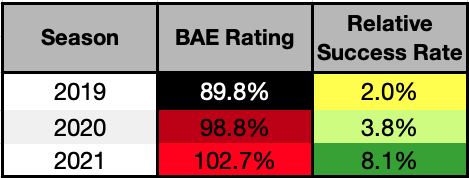
I’m not a doctor. And I don’t have any insider information as to what White’s recovery from his knee injuries has looked like. But it seems bad that he’s still not posting impressive efficiency numbers three years removed from that 2018 ACL tear. If he’s back to full strength, then his numbers are worrisome. If he’s not yet back to full strength, that seems worrisome on its own.
More Efficiency Context
What is not worrisome is Zamir White‘s Relative Success Rate numbers. He’s been a more consistent runner in every season of his career than some really good backfield mates at Georgia. And the 8.1-percent mark he posted in 2021 would be right there with the career marks of Dameon Pierce, Kenneth Walker, and Kevin Harris at the top of the 2022 class.
The numbers here paint the picture of a steady runner without much juice. The ancillary metrics make sense with that characterization as well. White doesn’t break tackles at a tremendous rate. And his performance in the open field has not been impressive.
All of that looks rather strange when considered next to his 4.40 speed. Given his dynamic physical profile in combination with the above efficiency metrics, the most similar historical prospects to White from a “pure runner” perspective are:
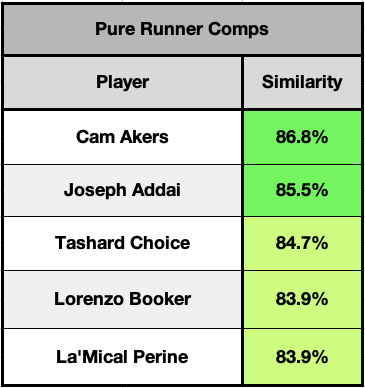
The royal “we” certainly likes the idea of Cam Akers, and Joseph Addai was a legitimately good NFL player. It’s also worth mentioning that Addai is on this list mostly based on his strong athleticism-based similarity to White. Addai’s career YPC+ was a 0.88 mark that lands in the 64th-percentile. And he did that relative to teammates who averaged a 4.29-star rating as high school recruits. I think his similarities to White as a runner are mostly superficial.
Outside of those two guys, the comps are not great for a fast guy who didn’t manage to outdo the efficiency of his college teammates.
Receiving Chops
At this point in his development, catching passes is not a strong part of Zamir White‘s game:
There’s really no data-based indicator that White will be even a passable receiver in the NFL. He wasn’t very involved in the passing game, he wasn’t used dynamically, and he wasn’t efficient on his targets. The best thing about his receiving profile is his YAC per reception numbers. Which is more indicative of his ability with the ball in his hands than his ability as an actual receiver.
Based on the above metrics, the historical prospects with the receiving profiles most similar to White’s are the following:
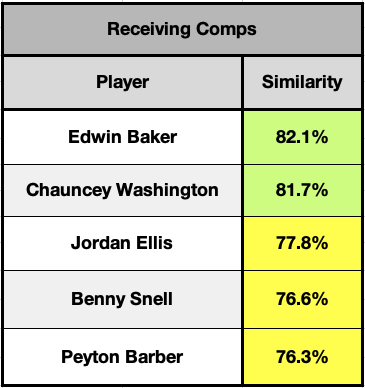
None of these guys have been quality receivers in the NFL, and it’s unlikely that White ever will be.
Overall Profile
It’s difficult to reconcile Zamir White‘s dynamic athletic profile (or at least his speed) with the poor numbers he put on wax as a runner in college. Much of his ineffectiveness is probably attributable to his injury history. But 2021 was three years removed from his last significant injury and he still wasn’t impressive.
This doesn’t even make any sense to me, but he’s a plodder with speed. He’s purely a two-down back and his calling card is consistently churning out positive yardage without adding much extra value. Despite his 40 time, that’s the textbook definition of a plodder.
Given White’s complete profile, here are the historical players who were most similar as prospects:
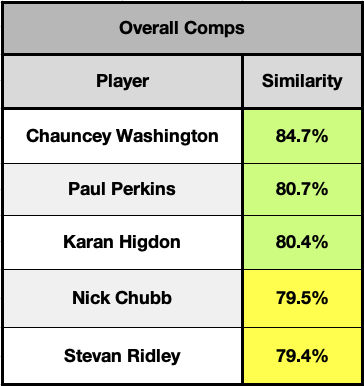
Given that he went to a blue blood program and was fast at the Combine, I think it’s likely that White gets selected in the third round or earlier in the upcoming NFL Draft. In that event, he’ll have a much easier time being a productive fantasy guy. But I think his limitations as a pass-catcher and a runner cap his ceiling. He’s a steady guy with unrealized athletic traits, but I think he maxes out as a committee back.
Personally, I hope White gets high draft capital that would allow me to stock up on better, cheaper options that get pushed down as a result of his value inflation.






